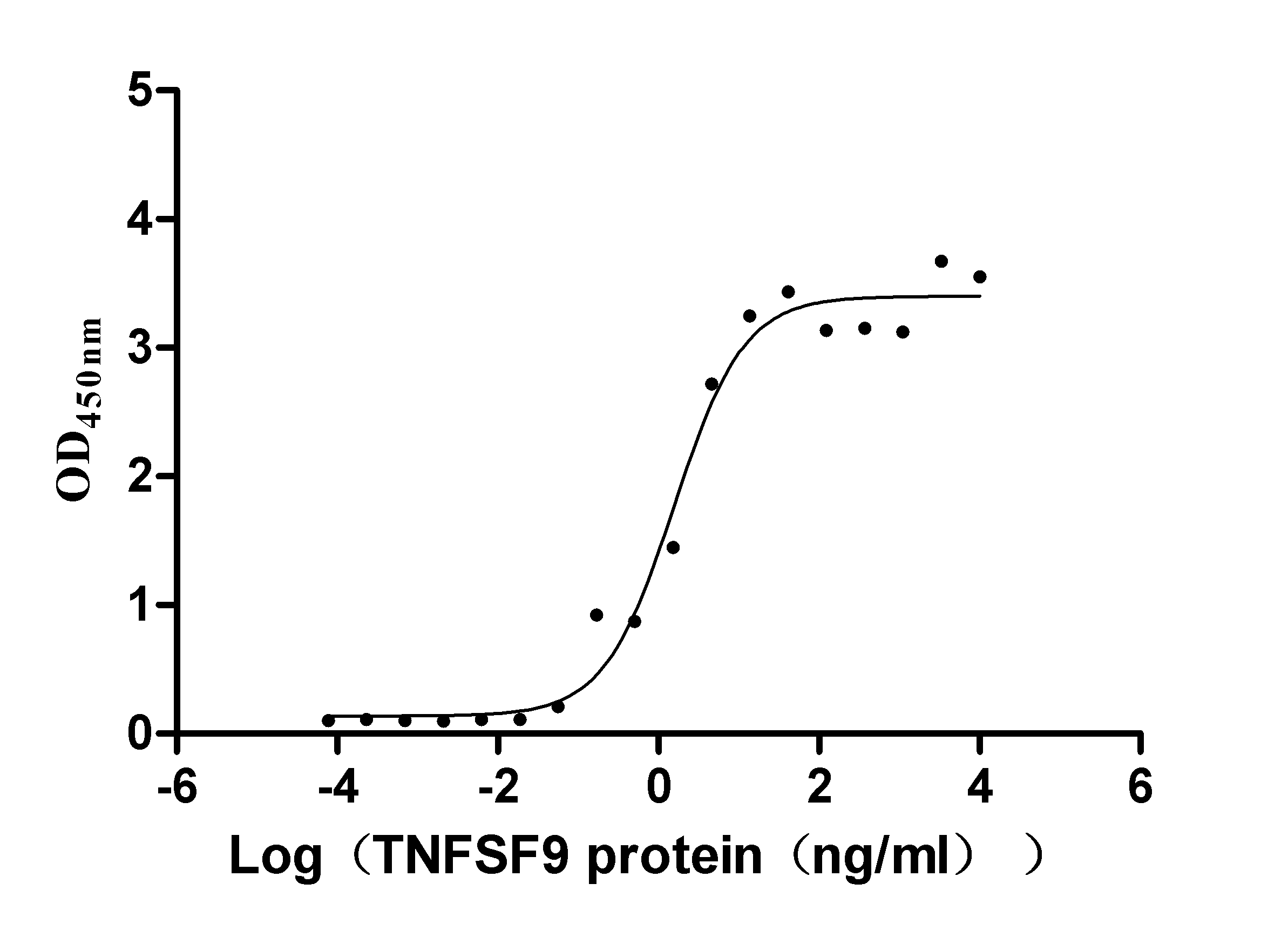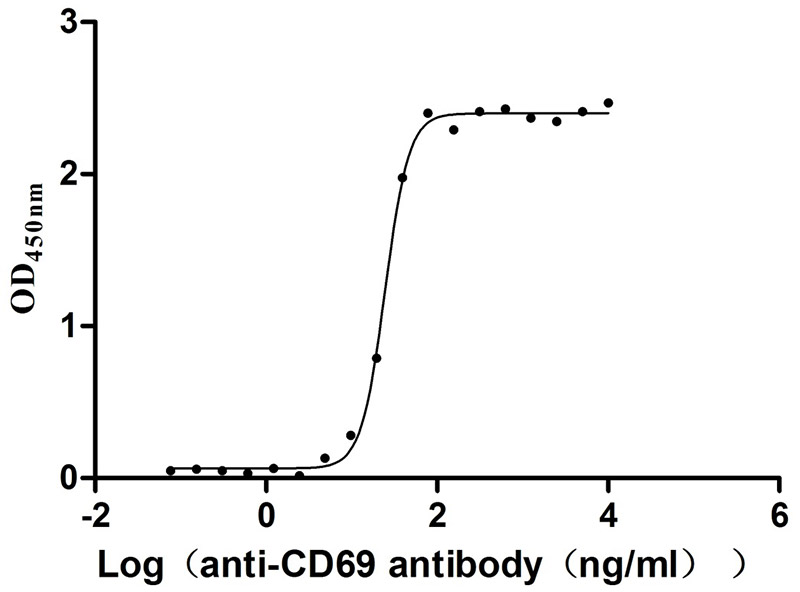Recombinant Human Formin-binding protein 1 (FNBP1)
-
中文名称:人FNBP1重组蛋白
-
货号:CSB-YP822300HU
-
规格:
-
来源:Yeast
-
其他:
-
中文名称:人FNBP1重组蛋白
-
货号:CSB-EP822300HU
-
规格:
-
来源:E.coli
-
其他:
-
中文名称:人FNBP1重组蛋白
-
货号:CSB-EP822300HU-B
-
规格:
-
来源:E.coli
-
共轭:Avi-tag Biotinylated
E. coli biotin ligase (BirA) is highly specific in covalently attaching biotin to the 15 amino acid AviTag peptide. This recombinant protein was biotinylated in vivo by AviTag-BirA technology, which method is BriA catalyzes amide linkage between the biotin and the specific lysine of the AviTag.
-
其他:
-
中文名称:人FNBP1重组蛋白
-
货号:CSB-BP822300HU
-
规格:
-
来源:Baculovirus
-
其他:
-
中文名称:人FNBP1重组蛋白
-
货号:CSB-MP822300HU
-
规格:
-
来源:Mammalian cell
-
其他:
产品详情
-
纯度:>85% (SDS-PAGE)
-
基因名:FNBP1
-
Uniprot No.:
-
别名:FBP1; FBP17; Fnbp1; FNBP1_HUMAN; Formin binding protein 1; Formin binding protein 17; Formin-binding protein 1; Formin-binding protein 17; hFBP17; KIAA0554; MGC126804
-
种属:Homo sapiens (Human)
-
蛋白长度:full length protein
-
表达区域:1-617
-
氨基酸序列MSWGTELWDQ FDNLEKHTQW GIDILEKYIK FVKERTEIEL SYAKQLRNLS KKYQPKKNSK EEEEYKYTSC KAFISNLNEM NDYAGQHEVI SENMASQIIV DLARYVQELK QERKSNFHDG RKAQQHIETC WKQLESSKRR FERDCKEADR AQQYFEKMDA DINVTKADVE KARQQAQIRH QMAEDSKADY SSILQKFNHE QHEYYHTHIP NIFQKIQEME ERRIVRMGES MKTYAEVDRQ VIPIIGKCLD GIVKAAESID QKNDSQLVIE AYKSGFEPPG DIEFEDYTQP MKRTVSDNSL SNSRGEGKPD LKFGGKSKGK LWPFIKKNKL MSLLTSPHQP PPPPPASASP SAVPNGPQSP KQQKEPLSHR FNEFMTSKPK IHCFRSLKRG LSLKLGATPE DFSNLPPEQR RKKLQQKVDE LNKEIQKEMD QRDAITKMKD VYLKNPQMGD PASLDHKLAE VSQNIEKLRV ETQKFEAWLA EVEGRLPARS EQARRQSGLY DSQNPPTVNN CAQDRESPDG SYTEEQSQES EMKVLATDFD DEFDDEEPLP AIGTCKALYT FEGQNEGTIS VVEGETLYVI EEDKGDGWTR IRRNEDEEGY VPTSYVEVCL DKNAKDS
-
蛋白标签:Tag type will be determined during the manufacturing process.
The tag type will be determined during production process. If you have specified tag type, please tell us and we will develop the specified tag preferentially. -
产品提供形式:Lyophilized powder
Note: We will preferentially ship the format that we have in stock, however, if you have any special requirement for the format, please remark your requirement when placing the order, we will prepare according to your demand. -
复溶:We recommend that this vial be briefly centrifuged prior to opening to bring the contents to the bottom. Please reconstitute protein in deionized sterile water to a concentration of 0.1-1.0 mg/mL.We recommend to add 5-50% of glycerol (final concentration) and aliquot for long-term storage at -20℃/-80℃. Our default final concentration of glycerol is 50%. Customers could use it as reference.
-
储存条件:Store at -20°C/-80°C upon receipt, aliquoting is necessary for mutiple use. Avoid repeated freeze-thaw cycles.
-
保质期:The shelf life is related to many factors, storage state, buffer ingredients, storage temperature and the stability of the protein itself.
Generally, the shelf life of liquid form is 6 months at -20°C/-80°C. The shelf life of lyophilized form is 12 months at -20°C/-80°C. -
货期:Delivery time may differ from different purchasing way or location, please kindly consult your local distributors for specific delivery time.Note: All of our proteins are default shipped with normal blue ice packs, if you request to ship with dry ice, please communicate with us in advance and extra fees will be charged.
-
注意事项:Repeated freezing and thawing is not recommended. Store working aliquots at 4°C for up to one week.
-
Datasheet :Please contact us to get it.
靶点详情
-
功能:May act as a link between RND2 signaling and regulation of the actin cytoskeleton. Required to coordinate membrane tubulation with reorganization of the actin cytoskeleton during the late stage of clathrin-mediated endocytosis. Binds to lipids such as phosphatidylinositol 4,5-bisphosphate and phosphatidylserine and promotes membrane invagination and the formation of tubules. Also enhances actin polymerization via the recruitment of WASL/N-WASP, which in turn activates the Arp2/3 complex. Actin polymerization may promote the fission of membrane tubules to form endocytic vesicles. May be required for the lysosomal retention of FASLG/FASL.
-
基因功能参考文献:
- Results suggest that FBP17 is highly expressed in breast cancer cells and facilitates the invasion of breast cancer cells. PMID: 29651632
- FBP17 is the local activator of actin polymerization that is inhibited by PM tension in the feedback loop that regulates cell migration. PMID: 25938814
- Knockdown of PSTPIP2 inmacrophages enhances the assembly of FBP17, leading to'hyperactivation' of actin nucleation at podosomes and ECM degradation. PMID: 23525018
- F-BAR protein Rapostlin, whose activity is regulated by Rnd2, plays a key role in spine formation through the regulation of membrane dynamics. PMID: 21768103
- Results suggest a functional link between FBP17-dependent membrane tubulation and clathrin-dependent budding. Clathrin spatially directs membrane invaginations that lead to the generation of endocytic vesicles larger than those enclosed by the coat. PMID: 20729836
- co-immunoprecipitation of endogenous proteins in 293T cells confirms physiological relevance of TNKS as interaction partner of FBP17 PMID: 14596906
- FBP17 interacts with dynamin and regulates endocytosis by forming vesicotubular structures PMID: 15252009
- Data indicate that PCH protein family members such as FBP17 couple membrane deformation to actin cytoskeleton reorganization in various cellular processes. PMID: 16418535
- FBP17 is recruited to clathrin-coated pits in the late stage of endocytosis, indicating its physiological role. PMID: 17512409
- N-WASP-WIP complex-mediated actin polymerization is activated by phosphatidylserine-containing membranes depending on membrane curvature in the presence of Toca-1 or FBP17 and in the absence of Cdc42 and phosphatidylinositol (4,5)-bisphosphate. PMID: 18923421
- formin-binding protein 17 (FBP17) recruits WASP, WASP-interacting protein (WIP), and dynamin-2 to the plasma membrane and that this recruitment is necessary for the formation of podosomes and phagocytic cups. PMID: 19155218
- Rat rapostlin protein has 93% aa identity to human FBP17. PMID: 12244061
- FNBP1 family proteins (FNBP1 and TRIP10) consist of FCH, FBH and SH3 domains. PMID: 12736724
显示更多
收起更多
-
相关疾病:A chromosomal aberration involving FNBP1 is found in acute leukemias. Translocation t(9;11)(q34;q23) with KMT2A/MLL1. The relatively low incidence of the KMT2A/MLL1-FNBP1 fusion protein in acute leukemia may reflect the marginal capacity of this fusion protein to induce cellular transformation.
-
亚细胞定位:Cytoplasm. Cytoplasm, cytoskeleton. Cytoplasm, cell cortex. Lysosome. Cytoplasmic vesicle. Cell membrane; Peripheral membrane protein; Cytoplasmic side. Membrane, clathrin-coated pit. Note=Enriched in cortical regions coincident with F-actin. Also localizes to endocytic vesicles and lysosomes.
-
蛋白家族:FNBP1 family
-
组织特异性:Very highly expressed in the epithelial cells of the gastrointestinal tract, respiratory, reproductive and urinary systems. Also highly expressed in brown adipose tissue, cardiomyocytes, enteric ganglia and glucagon producing cells of the pancreas. Expres
-
数据库链接:
HGNC: 17069
OMIM: 606191
KEGG: hsa:23048
STRING: 9606.ENSP00000413625
UniGene: Hs.189409
Most popular with customers
-
Recombinant Human Tumor necrosis factor receptor superfamily member 9 (TNFRSF9), partial (Active)
Express system: Mammalian cell
Species: Homo sapiens (Human)
-
Recombinant Human B-lymphocyte antigen CD20 (MS4A1)-VLPs (Active)
Express system: Mammalian cell
Species: Homo sapiens (Human)
-
Recombinant Mouse Tyrosine-protein kinase Mer (Mertk), partial (Active)
Express system: Mammalian cell
Species: Mus musculus (Mouse)
-
Recombinant Human Claudin-9 (CLDN9)-VLPs (Active)
Express system: Mammalian cell
Species: Homo sapiens (Human)
-
Recombinant Human Desmoglein-3 (DSG3), partial (Active)
Express system: Baculovirus
Species: Homo sapiens (Human)
-
Recombinant Human C-C chemokine receptor type 8 (CCR8)-VLPs (Active)
Express system: Mammalian cell
Species: Homo sapiens (Human)
-
Recombinant Human Early activation antigen CD69 (CD69), partial (Active)
Express system: Mammalian cell
Species: Homo sapiens (Human)
-
Recombinant Human Dipeptidase 3(DPEP3), partial (Active)
Express system: Mammalian cell
Species: Homo sapiens (Human)




















